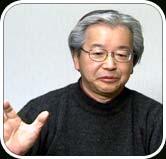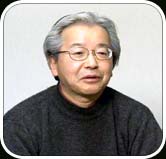 |


File size : 18.2MB
Format : MPEG |
|
Q. What would you like to do with JAXA in the future? Is there anything you expect from JAXA?
Observation from space is very important for astronomy. ISAS (now a part of JAXA) has launched many astronomical satellites, which are a significant addition to ground-based telescopes because in space the Earth’s atmosphere does not present an obstacle. With clouds in the sky, you can’t do observation with visible light, which barely travels through air, and besides, the images are blurred. And with radio waves, there is interference from electrons in the Earth’s ionosphere when the wavelength is too long. And if the wavelength is too short, vapor becomes an obstacle. And in addition, air doesn’t let X-rays get through at all. So all this means that as long as you have air above you, the range of space observation is very limited.
Observation from the ground is possible with a type of light called near-infrared, which has a wavelength that is slightly long, and radio waves that are electromagnetic and have much longer wavelengths. The equipment for these observations is optical-infrared telescopes (such as Subaru), which are quite large and complicated, and also radio telescopes (such as the Nobeyama Millimeter array). But it is very difficult to launch such large telescopes into space. Even if we wanted to, it would be impossible to launch the Subaru telescope or a 45-meter radio telescope at present. So, instead, we launch a telescope for X-rays that cannot be observed on the ground, and a comparatively small telescope to observe infrared light with long wavelength. That allows us to make new observations, and to see a different face of space.
Black holes are a good example. We succeeded in confirming the existence of a black hole by launching an X-ray observation satellite. It would have been very difficult to see the black hole from the ground. A recent discovery is gamma-ray bursters. These are celestial bodies that vanish after emitting extremely strong light energy called gamma rays. A lot of them have been found lately, and the discovery was made, again, by a satellite launched to observe gamma rays. Space is still full of mysteries for us, and therefore it is important to send observation equipment into space.
As for NAOJ’s relationship with JAXA, I think astronomy from the ground and astronomy from space will keep growing closer. In the past, it was more like NAOJ was in charge of building ground telescopes, and ISAS was in charge of launching satellites, but that will change. In the future, the relationship will be both more complicated and closer.
 Some NAOJ research groups are interested in launching observatory equipment into space, and are already looking into it. Of course, they are also involved in discussions with JAXA about its own future observational-satellite plan. Such collaboration is now inevitable for space observation in Japan. NAOJ will also be doing satellite-based space observation in the future. The cooperation used to be limited to the observation, but NAOJ’s contribution will grow not only in research but also in technology development. For instance, solar satellite SOLAR-B is scheduled to be launched soon, and tests on its light telescope have been done at NAOJ. We’ve built a large clean room, where we are doing various optical tests. Such collaboration will be much more common in the future. Some NAOJ research groups are interested in launching observatory equipment into space, and are already looking into it. Of course, they are also involved in discussions with JAXA about its own future observational-satellite plan. Such collaboration is now inevitable for space observation in Japan. NAOJ will also be doing satellite-based space observation in the future. The cooperation used to be limited to the observation, but NAOJ’s contribution will grow not only in research but also in technology development. For instance, solar satellite SOLAR-B is scheduled to be launched soon, and tests on its light telescope have been done at NAOJ. We’ve built a large clean room, where we are doing various optical tests. Such collaboration will be much more common in the future.
Last year, as those large organizations, the Institute of Space and Astronautical Science, the National Aerospace Laboratory of Japan, and the National Space Development Agency of Japan, were merged, Japan’s space development and space science were put together under one roof. |
 |
 |
 |


File size : 9.2MB
Format : MPEG |
|
To be honest, there is still some concern about whether the top-down merger was good or bad. This is because it wasn’t a case of the government and the agencies making the decision together, simply for the purpose of further developing each of the agencies’ fields. The purpose was more likely cutting spending and staff. In today’s Japan, everything works that way, and nobody knows what to do to improve science, technology and education. People on the ground are doing their best. But it seems that what we are hearing is that the top priority for the merged organization is to reduce spending. You can’t blame the staff for having some concerns.
JAXA is not the only agency in this situation. The Ministry of Finance says that it is reducing its expenditure for national universities, since they are now privatized. The same is true of NAOJ, which is a member of the Inter-University Research Institute. Since the institute is an organization affiliated with national universities, it has become privatized as well. And after privatization, as soon as some laboratories merge into new organizations, they are told to cut spending. Of course, the Ministry of Education, Culture, Sports, Science and Technology opposes this.
We understand that Japan’s finances are not healthy now, so we should watch our expenses. But when mergers are urged simply for the purpose of reducing expenses, everyone feels intimidated, and it’s a serious discouragement. I’m afraid that one day Japan’s science and technology will become introverted in the name of efficiency and economy.
Meanwhile, I expect JAXA to try to mitigate the effects of the merger for the long-term promotion of science. We completely understand that things won’t be easy for a while. I’m hoping, though, that we will also be able to do some things that we couldn’t do before the merger and privatization. For instance, I’m expecting that the use of the International Space Station will be changed. And I think it will be wonderful if the merger succeeds in combining each of the former organizations’ strengths, such as ISAS’s opportunities for leading world-class scientific research, and NASDA’s aggressiveness in making projects happen. I expect the merger not to be something that just happens on paper, but to bring us great results.
|


File size : 8.3MB
Format : MPEG |
|
Q. How do you see the significance of astronomical and space research?
No matter how you put it, I think basic science has limits in its practical usefulness in our daily life. It’s rather more important that people think it interesting - in other words, that it appeal to people’s intellectual curiosity. Of course, we, the staff, are doing this research because we’re fascinated with new discoveries that expand our understanding of our world and of the universe. We find it very interesting and also very important. It is such a joy for us, but it has to be so for the general public as well. Otherwise, our efforts are meaningless. The joy has to be shared with the public. It’s becoming more and more important to have the attitude that our fascination and our results must be communicated to society at large, but unfortunately Japan is still behind in this aspect. Our research is carried out using tax money, so therefore it’s important that the significance of our research be accepted by the public. It’s delightful if society finds our work interesting.
The budget for the Nobeyama radio telescope, which was completed in 1982, was 11 billion yen, the largest budget for a natural scientific project back then. That means that, from babies to the elderly, the nation paid 100 yen per person. I used to say that a key to this was whether the public would accept the work we did after we collected 100 yen from everyone. In other words, the work would be good enough if people thought it was worth paying 100 yen to learn something interesting; but if they didn’t see the importance of the work, we didn’t deserve to receive that much money from them. If you calculate the cost of the Subaru telescope the same way, it was 350 yen that we got from each person. I have always told visitors, "the Subaru was built thanks to your ’cup of coffee.’ "
This is just one way of thinking, but I’ve been working with this thought on my mind. If each researcher becomes aware of the value of the money they’re spending on their work, it will motivate them to get good and interesting observations, and to tell the public about them. |
|
 |

